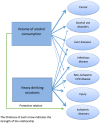The relationship between different dimensions of alcohol use and the burden of disease-an update
- PMID: 28220587
- PMCID: PMC5434904
- DOI: 10.1111/add.13757
The relationship between different dimensions of alcohol use and the burden of disease-an update
Abstract
Background and aims: Alcohol use is a major contributor to injuries, mortality and the burden of disease. This review updates knowledge on risk relations between dimensions of alcohol use and health outcomes to be used in global and national Comparative Risk Assessments (CRAs).
Methods: Systematic review of reviews and meta-analyses on alcohol consumption and health outcomes attributable to alcohol use. For dimensions of exposure: volume of alcohol use, blood alcohol concentration and patterns of drinking, in particular heavy drinking occasions were studied. For liver cirrhosis, quality of alcohol was additionally considered. For all outcomes (mortality and/or morbidity): cause of death and disease/injury categories based on International Classification of Diseases (ICD) codes used in global CRAs; harm to others.
Results: In total, 255 reviews and meta-analyses were identified. Alcohol use was found to be linked causally to many disease and injury categories, with more than 40 ICD-10 three-digit categories being fully attributable to alcohol. Most partially attributable disease categories showed monotonic relationships with volume of alcohol use: the more alcohol consumed, the higher the risk of disease or death. Exceptions were ischaemic diseases and diabetes, with curvilinear relationships, and with beneficial effects of light to moderate drinking in people without heavy irregular drinking occasions. Biological pathways suggest an impact of heavy drinking occasions on additional diseases; however, the lack of medical epidemiological studies measuring this dimension of alcohol use precluded an in-depth analysis. For injuries, except suicide, blood alcohol concentration was the most important dimension of alcohol use. Alcohol use caused marked harm to others, which has not yet been researched sufficiently.
Conclusions: Research since 2010 confirms the importance of alcohol use as a risk factor for disease and injuries; for some health outcomes, more than one dimension of use needs to be considered. Epidemiological studies should include measurement of heavy drinking occasions in line with biological knowledge.
Keywords: Alcohol use; average volume; chronic disease; injury; patterns of drinking; risk-relations; systematic review; unrecorded consumption.
© 2017 The Authors. Addiction published by John Wiley & Sons Ltd on behalf of Society for the Study of Addiction.
Figures
Comment in
-
Commentary on Rehm et al. (2017): Composition of alcoholic beverages-an under-researched dimension in the global comparative risk assessment.Addiction. 2017 Jun;112(6):1002-1003. doi: 10.1111/add.13790. Addiction. 2017. PMID: 28447430 No abstract available.
-
The contribution of unrecorded alcohol to health harm.Addiction. 2017 Sep;112(9):1687-1688. doi: 10.1111/add.13865. Epub 2017 Jun 20. Addiction. 2017. PMID: 28635161 No abstract available.
References
-
- Global Burden of Disease (GBD) 2015. Risk Factors Collaborators Global, regional, and national comparative risk assessment of 79 behavioral, environmental and occupational, and metabolic risks or clusters of risks, 1990–2015: a systematic analysis for the Global Burden of Disease Study 2015. Lancet 2016; 388: 1659–1724. - PMC - PubMed
-
- Forouzanfar M. H., Alexander L., Anderson H. R., Bachman V. F., Biryukov S., Brauer M. et al. Global, regional, and national comparative risk assessment of 79 behavioural, environmental and occupational, and metabolic risks or clusters of risks in 188 countries, 1990–2013: a systematic analysis for the Global Burden of Disease Study 2013. Lancet 2015; 386: 2287–2323. - PMC - PubMed
-
- Lim S. S., Vos T., Flaxman A. D., Danaei G., Shibuya K., Adair‐Rohani H. et al. A comparative risk assessment of burden of disease and injury attributable to 67 risk factors and risk factor clusters in 21 regions, 1990–2010: a systematic analysis for the Global Burden of Disease Study 2010. Lancet 2012; 380: 2224–2260. - PMC - PubMed
-
- Rehm J., Room R., Monteiro M., Gmel G., Graham K., Rehn N. et al. Alcohol use In: Ezzati M., Lopez A. D., Rodgers A., Murray C. J. L., editors. Comparative Quantification of Health Risks: Global and Regional Burden Of Disease Attributable To Selected Major Risk Factors. Geneva, Switzerland: World Health Organization; 2004, pp. 959–1109.
Publication types
MeSH terms
Grants and funding
LinkOut - more resources
Full Text Sources
Other Literature Sources
Medical
Molecular Biology Databases


